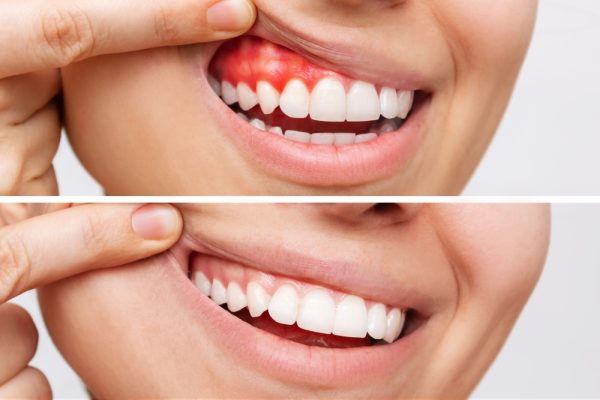Recognize and Treat Early Periodontitis with Our Seattle Dentists
Table of Contents
As a trusted dentist in Seattle, Dr. Johnson understands the importance of maintaining good oral health and preventing dental problems before they progress. Gum disease is a common condition that affects many people, and, if left untreated, can lead to serious dental problems. By understanding the signs and seeking treatment early, you can prevent the condition from progressing to advanced periodontal disease and ensure good oral health for years to come.
To schedule your appointment, call us at (206) 682-3888.
What Is Early Periodontitis?
Early periodontitis is a type of periodontal disease that occurs when there’s inflammation of the gums due to tartar and plaque buildup. The inflammation is caused by the bacteria in the plaque that accumulates on the teeth. When the plaque isn’t removed, it can harden and turn into tartar, leading to the formation of periodontal pockets between the teeth and gums. These pockets can become infected, which can destroy the bone that supports the teeth.
This stage of gum disease is usually painless, which is why many people may not even realize that they have it. However, if left untreated, it can progress to a more severe form of gum disease, known as periodontitis. This can result in tooth loss and other serious dental problems.

Symptoms of Early Periodontitis
The symptoms of early-stage periodontitis may not be immediately noticeable, but there are warning signs that you can look out for. The most common symptoms include:
- Red and Swollen Gums: Gum disease causes inflammation of the gums, leading to redness and swelling. The gums may appear shiny and puffy.
- Bleeding Gums: One of the most common signs of periodontal disease is bleeding gums, especially during brushing or flossing. Healthy gums shouldn’t bleed during routine oral care.
- Gum Sensitivity: Gum disease can make the gums tender and sensitive to the touch. You may experience discomfort or pain while brushing, flossing, or eating certain foods.
- Bad Breath (halitosis): Persistent bad breath can be a sign of this stage of gum disease. Bacteria in the mouth produce toxins that cause an unpleasant odor.
- Receding Gums: As gingivitis progresses, the gum tissue may start to pull away from the teeth, causing the gums to recede. This can make the teeth appear longer than usual.
- Formation of pockets: Shallow periodontal pockets may develop between the teeth and gums. These pockets can trap food particles and bacteria, contributing to further gum inflammation.
- Loose Teeth: The supporting bone structures that hold the teeth in place, such as gum tissue and the jawbone, can become weakened or damaged, causing your teeth to loosen.
If you experience any of these symptoms, make an appointment with our dentist as soon as possible for an examination.
Diagnosing Your Stage of Gum Disease
If you have concerns about gum disease, our dentists will perform a dental exam to determine if you have the condition. The exam may involve the following techniques:
- Visual Inspection: Your dentist will visually examine your teeth and gums for signs of inflammation, bleeding, discoloration, and plaque buildup. They may also look for pockets or gaps between your teeth and gums.
- Probing: They may use a periodontal probe to measure the depth of the pockets between the teeth and gums. Healthy pockets are typically 1 to 3 mm deep, while deeper pockets may indicate gum disease.
- X-rays: Our dentist may take X-rays of the teeth and jaw to check for bone loss, which is often a complication of periodontal disease.
Based on the results, our dentist can determine whether or not a patient has developed early periodontitis and develop a treatment plan. Early intervention is critical to prevent gum disease from progressing into a more aggressive form that can cause tooth loss.

Treatment Options
The treatment for early-stage periodontitis depends on the severity of the condition. Your dentist may recommend a few different treatments based on your oral health situation.
Scaling and Root Planing
Scaling and root planing is a non-surgical procedure that involves removing plaque and calculus buildup from the teeth and root surfaces. Your dentist will use special instruments to clean the gums thoroughly, helping reverse the symptoms of gum disease.
Antibiotics
In certain cases, your dentist may prescribe antibiotics to help control the bacterial infection. They can be taken orally or applied directly to the affected areas of your gums.
Improved Oral Hygiene Practices
Patients with gum disease, no matter what stage, are advised to improve and practice good oral hygiene at home to prevent the disease from worsening. These habits include brushing your teeth twice a day with a soft-bristled toothbrush, flossing daily, and using an antiseptic mouthwash.
Regular Dental Visits
Regular dental cleanings and exams are essential for maintaining excellent oral health. While they’re typically recommended twice a year, your dentist may recommend more frequent dental cleanings, such as every three to months.
Lifestyle Changes
Patients with early periodontitis are often advised to make lifestyle changes to improve their overall health. This may include quitting smoking, reducing alcohol consumption, and eating a healthy diet.
Frequently Asked Questions
Yes, early-stage periodontitis can be prevented by maintaining good oral hygiene practices at home, such as brushing twice a day, flossing daily, and using an antimicrobial mouthwash as recommended by your dentist.
Yes, early periodontitis should be taken seriously as it can progress to a more severe form of gum disease if left untreated. More advanced stages of periodontal disease can result in tooth loss and other serious dental problems.
While maintaining good oral hygiene practices at home is important for preventing the condition, early periodontitis should be treated by a dental professional. A professional cleaning and other treatments may be necessary to properly address gum disease.
If you experience any symptoms of early-stage periodontitis, such as swollen or bleeding gums, bad breath, or red gums, make an appointment with your dentist as soon as possible for an examination and treatment.
Prevention Is Possible With Professional Dental Care
If you suspect that you may be experiencing symptoms of early-stage periodontitis, don’t hesitate to contact our Seattle dentist today to schedule an appointment. With years of experience in providing top-quality dental care, we have the expertise and knowledge to diagnose and treat early periodontitis effectively.
Our friendly and experienced team is committed to helping you achieve optimal oral health and providing you with personalized care tailored to your unique needs. Contact us today to schedule your appointment and take the first step towards a healthy, beautiful smile.
